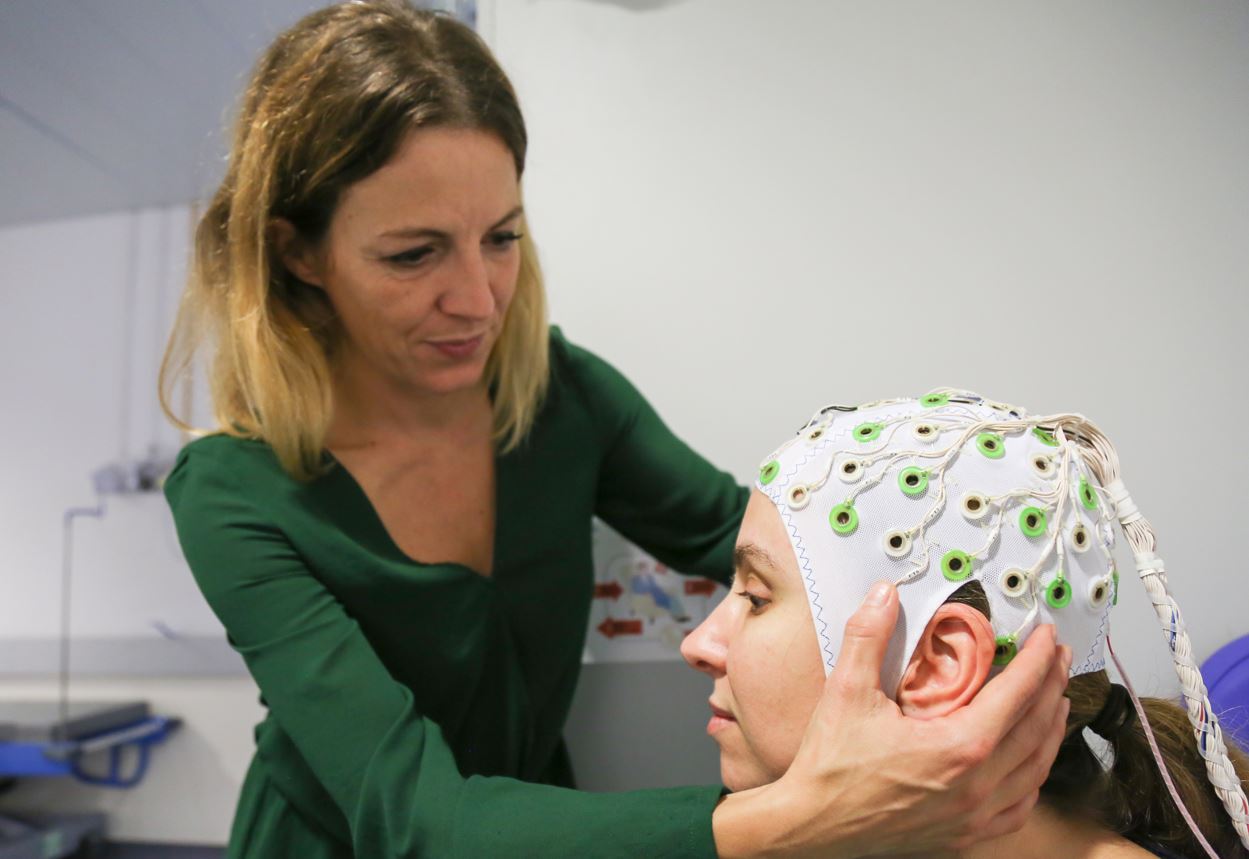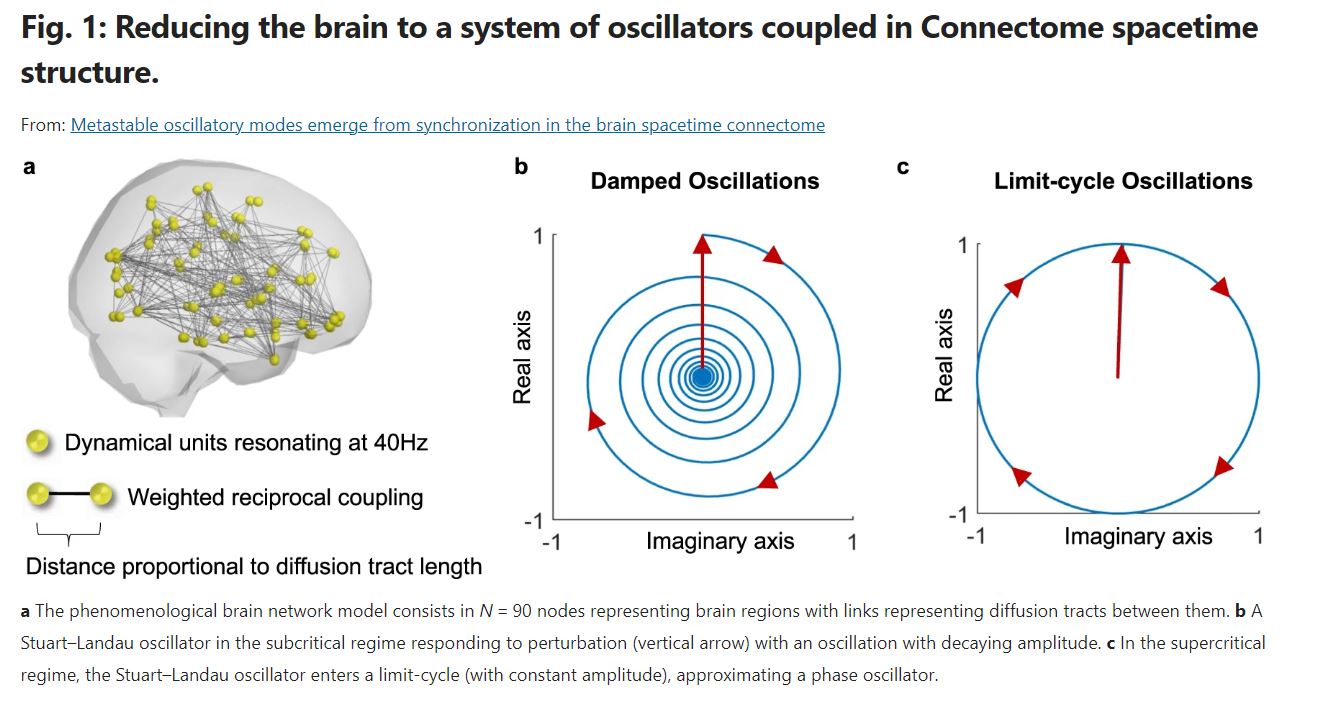A mechanical model to explain brain rhythms is the focus of an international research project involving the Center for Brain and Cognition
A mechanical model to explain brain rhythms is the focus of an international research project involving the Center for Brain and Cognition
Understanding the unresolved spontaneous emergence of these collective oscillations could allow the design of more precise therapeutic strategies for brain dysfunctions. This research is at the centre of an article, whose main author is Gustavo Deco, director of the UPF Center for Brain and Cognition, published recently in the journal Nature Communications Physics.

The proposal of a mechanistic theory to explain the emergence of brain rhythms, which could contribute to designing more precise therapeutic strategies, is the central theme of an article by an international team of researchers, whose main author is the director of the UPF Center for Brain and Cognition, Gustavo Deco, published recently in the journal Nature Communications Physics.
The article reveals how the brain keeps rhythm through a simple mechanical model with which the authors describe the behaviour of these waves. Understanding the emergence of brain rhythms could allow designing more precise therapeutic strategies aimed at modulating dysfunctional oscillatory brain activity.
In this regard, it should be borne in mind that the fundamental principles that coordinate these waves in the brain’s electromagnetic field are not yet fully known, which limits the progress of therapeutic strategies to rebalance pathological rhythms. Hence, the contribution of the research presented in this scientific article is relevant from the clinical standpoint.
Research conducted by an international, interdisciplinary team
The international, interdisciplinary team that has conducted this research consists of experts in neuroscience, physics, mathematics and advanced computational science. The article that presents its results, entitled “Metastable oscillatory modes emerge from synchronization in the brain spacetime connectome”, was published in the journal Nature Communications Physics in July of this year. In addition to Gustavo Deco, the other co-authors of the article are Joana Cabral (Institute for Research in Life and Health Sciences, University of Minho), Francesca Castaldo (a PhD student at the Wellcome Centre for Human Neuroimaging at University College London), Jakub Vohryzek (Oxford Computational Neuroscience, University of Oxford and postdoctoral researcher at UPF), Vladimir Litvak (UCL Queen Square Institute of Neurology), Christian Bick (Department of Mathematics, Vrije Universiteit Amsterdam), Renaud Lambiotte (Oxford Centre for Industrial and Applied Mathematics), Karl Friston (Institute of Neurology, University College London), and Morten L. Kringelbach (Department of Psychiatry, University of Oxford).
Patterns of brain rhythms can be explained in analogy to other natural phenomena, in which systems of units such as cells are involved in a collective behaviour
The unresolved spontaneous emergence of collective oscillations called brain rhythms is characteristic of electroencephalography (EEG) and magnetoencephalography (MEG) records. In fact, more than a century ago, researchers discovered periodic waves in the electrical signals detected from the scalp of living mammals.
The research by this international team shows that the patterns of brain rhythms detected in EEG and MEG recordings can be explained in analogy to other natural phenomena that are observed at multiple levels and scales in nature, where systems of interacting units - be they molecules, cells, or even living beings - engage in collective behaviour. The authors show that the principle of synchronization is sufficient to produce waves of electromagnetic signals similar to the known brain rhythms.
The research has simulated the brain network with 90 damped oscillators
To this end the study uses 90 damped oscillators coupled using the brain structural connectome to model and explain mathematically how collective waves can be generated with frequencies and durations qualitatively similar to the ones detected in the brain. Through this system, it has been possible to demonstrate that synchronization mechanisms can explain those collective oscillations well and that subtle changes in model parameters can explain different EEG features.

Joana Cabral (University of Minho, Portugal): “In this mathematical model of the brain network, the few milliseconds that the signals take to travel from one brain region to another is crucial to generate collective waves of activity”
“Here the key element is the time of transmission between brain areas”, explains Joana Cabral, from the Life and Health Sciences Research Institute of the University of Minho, Portugal, co-author of the article. “In this mathematical model of the brain network, the few milliseconds that the signals take to travel from one brain region to another is crucial to generate collective waves of activity. We can imagine the human waves in a stadium, where the time the collective wave takes to go around the stadium depends on the number of people and the reaction time between them. This phenomenon is predicted by general laws governing the synchronization of oscillators coupled with time delays and opens doors to understand what determines the rhythms detected experimentally in the brain”, Joana Cabral adds. Cabral completed her doctoral thesis at UPF.
Gustavo Deco (UPF) states that the signals generated by the mechanical model demonstrate the existence of a critical range of coupling in which the system is neither fully synchronous nor asynchronous: “Dynamical systems operating in this critical regime are the most sensitive to perturbation, increasing the capacity of information processing”
The signals generated by the model demonstrate the existence of a critical range of coupling in which the system is neither fully synchronous nor asynchronous, but some subsets of brain areas synchronize transiently driving the spontaneous emergence of collective waves similar to the ones detected with EEG and MEG. “Dynamical systems operating in this critical regime are the most sensitive to perturbation, increasing the capacity of information processing”, explains the principal researcher Gustavo Deco, director of the UPF Center for Brain and Cognition.
Francesca Castaldo (University College London): “Now our aim is to test the impact of distinct perturbation strategies in order to improve the efficacy of brain stimulation techniques to reduce the symptoms in neuropsychiatric disorders in which these rhythms are disrupted”
The similarity of the signals obtained from computer simulations with the experimentally recorded signals supports the validity of this mechanistic hypothesis. “Now our aim is to test the impact of distinct perturbation strategies in order to improve the efficacy of brain stimulation techniques to reduce the symptoms in neuropsychiatric disorders in which these rhythms are disrupted”, explains Francesca Castaldo, a doctoral student at the Wellcome Centre for Human Neuroimaging of University College London, funded by the European School of Network Neuroscience (euSNN), a Europe-wide training network for PhD students.
